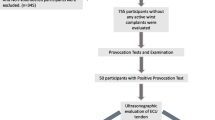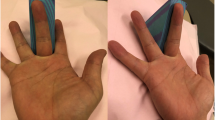Abstract
Background
Various provocative maneuvers for diagnosing extensor carpi ulnaris (ECU) tendinitis have been reported; however, it remains unclear which maneuver is the most sensitive to detect ECU tendinitis. To clarify this, we investigated and compared the extratendinous pressure and ECU tendon strain in the sixth extensor compartment of the wrist during various provocative maneuvers for diagnosing ECU tendinitis.
Methods
Nine upper extremities from nine fresh-frozen cadavers were examined. We investigated extratendinous pressure in the ECU fibro-osseous tunnel of the distal ulna and ECU tendon strain during eight forearm positions—neutral rotation, pronation, supination, pronation with wrist flexion, supination with wrist flexion, supination with wrist extension, both hand and forearm supination, and supination with ECU full loading—to simulate provocative maneuvers reported to detect ECU tendinitis.
Results
Pressure was significantly higher during both hand and forearm supination (carpal supination test) and during supination with wrist extension (prayer’s hand supination test) than during neutral rotation. The pressure during the carpal supination test was 3 times higher than that during the prayer’s hand supination test and 27 times higher than that during the neutral position. Strain was significantly higher during the carpal supination test and during supination with ECU full loading (the ECU synergy test) than during other maneuvers.
Conclusions
Both pressure and tendon strain increased most notably during the carpal supination test compared to the other maneuvers, which suggests that the carpal supination test is the most sensitive for the detection of ECU tendinitis.






Similar content being viewed by others
References
Aoki M, Takasaki H, Muraki T, Uchiyama E, Murakami G, Yamashita T. Strain on the ulnar nerve at the elbow and wrist during throwing motion. J Bone Joint Surg Am. 2005;87(11):2508–14.
Aso K, Nakamura T, Nakamura E. Diagnostic criteria of the extensor carpi ulnaris tenosynovitis. J Jpn Soc Surg Hand. 2000;17(3):280–2 (in Japanese).
Aso K, Uchida Y, Uchida K. Diagnosis and treatment of tenosynovitis of the extensor carpi ulnaris. J Jpn Soc Surg Hand. 2006;23(4):393–8 (in Japanese).
Futami T, Wakabayashi N, Ohotomo M, Tsukamoto Y, Yamamoto M. Extensor carpi ulnaris syndrome: a proposal of a new clinical entity. J Jpn Soc Surg Hand. 1989;6(3):499–504 (in Japanese).
Kobayashi M, Garcia-Elias M, Nagy L, Ritt MJ, An KN, Cooney WP, Linscheid RL. Axial loading induces rotation of the proximal carpal row bones around unique screw-displacement axes. J Biomech. 1997;30(11–12):1165–7.
Kotwica Z, Paciorek G. Usefulness of intracranial pressure measurement by Camino V420 system: preliminary report. Neurol Neurochir Pol. 1992;26(5):671–6.
Poca MA, Sahuquillo J, Arribas M, Baguena M, Amoros S, Rubio E. Fiberoptic intraparenchymal brain pressure monitoring with the Camino V420 monitor: reflections on our experience in 163 severely head-injured patients. J Neurotrauma. 2002;19(4):439–48.
Ruland RT, Hogan CJ. The ECU synergy test: an aid to diagnose ECU tendonitis. J Hand Surg Am. 2008;33(10):1777–82.
Takasaki H, Aoki M, Muraki T, Uchiyama E, Murakami G, Yamashita T. Muscle strain on the radial wrist extensors during motion-simulating stretching exercises for lateral epicondylitis: a cadaveric study. J Shoulder Elbow Surg. 2007;16(6):854–8.
Takasaki H, Aoki M, Oshiro S, Izumi T, Hidaka E, Fujii M, Tatsumi H. Strain reduction of the extensor carpi radialis brevis tendon proximal origin following the application of a forearm support band. J Orthop Sports Phys Ther. 2008;38(5):257–61.
Yoshida T. Ulnar-side wrist pain. J Jpn Soc Surg Hand. 2010;26(3):383–6 (in Japanese).
Kaplan EB. Functional and surgical anatomy of the hand. 2nd ed. Philadelphia: Lippincott Company; 1965. p. 191–4.
Taleisnik J. Pain on the ulnar side of the wrist. Hand Clin. 1987;3(1):51–68.
Nagaoka M. Tenosynovitis of the extensor carpi ulnaris. J Jpn Soc Surg Hand. 1994;11(2):252–5 (in Japanese).
Author information
Authors and Affiliations
Corresponding author
Ethics declarations
Conflict of interest
The authors declare that they have no conflict of interest.
Additional information
Institution where the work was done: Department of Orthopedic Surgery, Osaka University Graduate School of Medicine.
About this article
Cite this article
Kataoka, T., Moritomo, H., Omori, S. et al. Pressure and tendon strain in the sixth extensor compartment of the wrist during simulated provocative maneuvers for diagnosing extensor carpi ulnaris tendinitis. J Orthop Sci 20, 993–998 (2015). https://doi.org/10.1007/s00776-015-0772-y
Received:
Accepted:
Published:
Issue Date:
DOI: https://doi.org/10.1007/s00776-015-0772-y




